St
Giles' Hospital
Havil Street, Camberwell, SE5 7RN
Medical
dates:
Medical
character:
Acute
The Camberwell Workhouse opened
in 1818 in Havil Street, in the parish of St Giles.
Work began in 1873 to build a large infirmary to the north of the workhouse, at the junction with Brunswick Road (later renamed St Giles Road).
The Camberwell Workhouse Infirmary opened in 1875. It had a 5-storey central administration block, which contained offices, accommodation for staff, and special wards. On either side of this central block was a 3-storey wing - the north side one for men and the south side for women.
In 1890 a new 4-storey ward tower fronting onto Havil Street was opened. Circular in design (which was fashionable at that time), it had cost about £14,500. Each storey contained 24 beds radiating around a central shaft, in which heating and ventilation services were located.
The infirmary was extended again during 1899-1903, when more ward blocks, an operating theatre and a Nurses' Home were added. An administration block on the Brunswick Square side was also built, as well as new Guardians' offices on the southeast part of the site.
In 1913 it was renamed the Camberwell Parish Infirmary.
In 1930 its administration was taken over by the LCC. At this time it had 828 beds.
During WW2 the Infirmary was damaged by a V1 flying bomb, which also partly demolished Bentley House, an apartment block on the corner of St Giles Road and Peckham Road.
In 1948 the Infirmary joined the NHS and was renamed St Giles' Hospital, coming under the administrative control of the Camberwell Hospital Management Committee, which included St Francis' and Dulwich Hospitals.
By 1962 it had 343 beds. In 1966 it became part of the King's College Teaching Hospital Group and, four years later, the Nursing Schools of both Hospitals merged. In 1967 it had 384 beds.
By 1974 the Hospital had 283 beds.
The Hospital closed in 1983, and services were transferred to St Francis' and Dulwich Hospitals. It became a psychiatric Day Hospital in association with King's College Hospital.
Work began in 1873 to build a large infirmary to the north of the workhouse, at the junction with Brunswick Road (later renamed St Giles Road).
The Camberwell Workhouse Infirmary opened in 1875. It had a 5-storey central administration block, which contained offices, accommodation for staff, and special wards. On either side of this central block was a 3-storey wing - the north side one for men and the south side for women.
In 1890 a new 4-storey ward tower fronting onto Havil Street was opened. Circular in design (which was fashionable at that time), it had cost about £14,500. Each storey contained 24 beds radiating around a central shaft, in which heating and ventilation services were located.
The infirmary was extended again during 1899-1903, when more ward blocks, an operating theatre and a Nurses' Home were added. An administration block on the Brunswick Square side was also built, as well as new Guardians' offices on the southeast part of the site.
In 1913 it was renamed the Camberwell Parish Infirmary.
In 1930 its administration was taken over by the LCC. At this time it had 828 beds.
During WW2 the Infirmary was damaged by a V1 flying bomb, which also partly demolished Bentley House, an apartment block on the corner of St Giles Road and Peckham Road.
In 1948 the Infirmary joined the NHS and was renamed St Giles' Hospital, coming under the administrative control of the Camberwell Hospital Management Committee, which included St Francis' and Dulwich Hospitals.
By 1962 it had 343 beds. In 1966 it became part of the King's College Teaching Hospital Group and, four years later, the Nursing Schools of both Hospitals merged. In 1967 it had 384 beds.
By 1974 the Hospital had 283 beds.
The Hospital closed in 1983, and services were transferred to St Francis' and Dulwich Hospitals. It became a psychiatric Day Hospital in association with King's College Hospital.
Present status (January
2008)
Many buildings were not required and were demolished. The Grade II listed circular ward block built in 1889 has been converted into apartments - St Giles Tower. The NHS uses a small Arts & Crafts style building as a medical centre.
Many buildings were not required and were demolished. The Grade II listed circular ward block built in 1889 has been converted into apartments - St Giles Tower. The NHS uses a small Arts & Crafts style building as a medical centre.
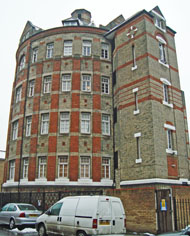
St Giles Tower on Havil Street.
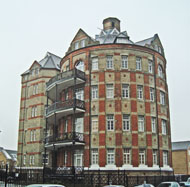
The other side of the circular tower.
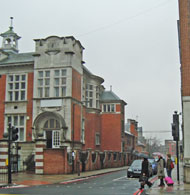
Looking down Havil Street.
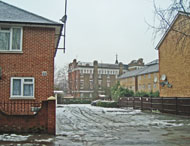
The view from Havil Street with new housing in the foreground and an old ward block in the background.

Former ward blocks on St Giles Road have been converted into apartment blocks.

St Giles Surgery at 40, St Giles Road
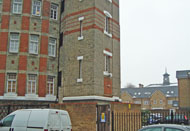
The clock tower of the administration building on St Giles Road can be seen in the distance beyond the St Giles Tower.
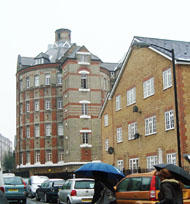
Looking south down Havil Street.
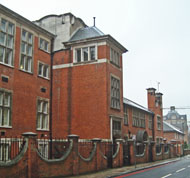
Havil Street frontage.
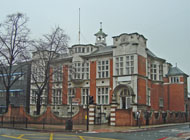
The former Guardians' Office at the corner of Havil Street and Peckham Road.
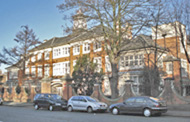
The administration block with its clock tower on St Giles Road has been converted into apartments.
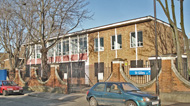
St Giles Day Hospital on the north part of the site, looking rather abandoned.
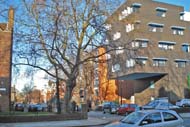
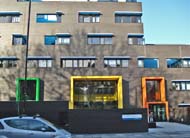
The south part of the site has been redeveloped and now contains Sunshine House, a Youth Service building on Peckham Road.
http://archiseek.com
http://collage.cityoflondon.gov.uk
http://hansard.millbanksystems.com
http://newnightingales.blogspot.co.uk
www.aim25.ac.uk
www.architectsjournal.co.uk
www.britishlistedbuildings.co.uk
www.flickr.com
www.flyingbombsandrockets.com
www.kingscollections.org
www.openwriting.com
www.telegraph.co.uk
www.workhouses.org.uk
Return to home page